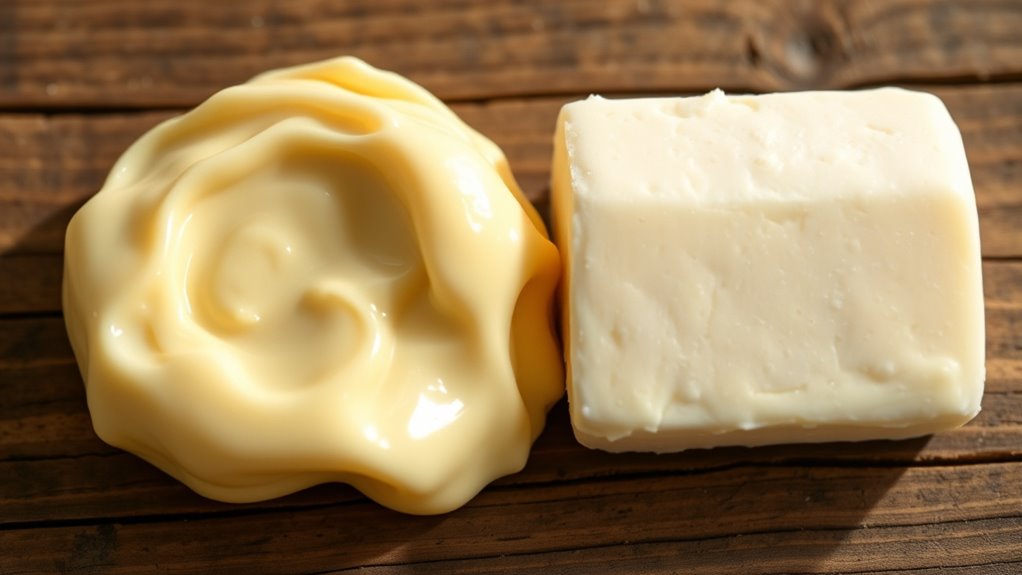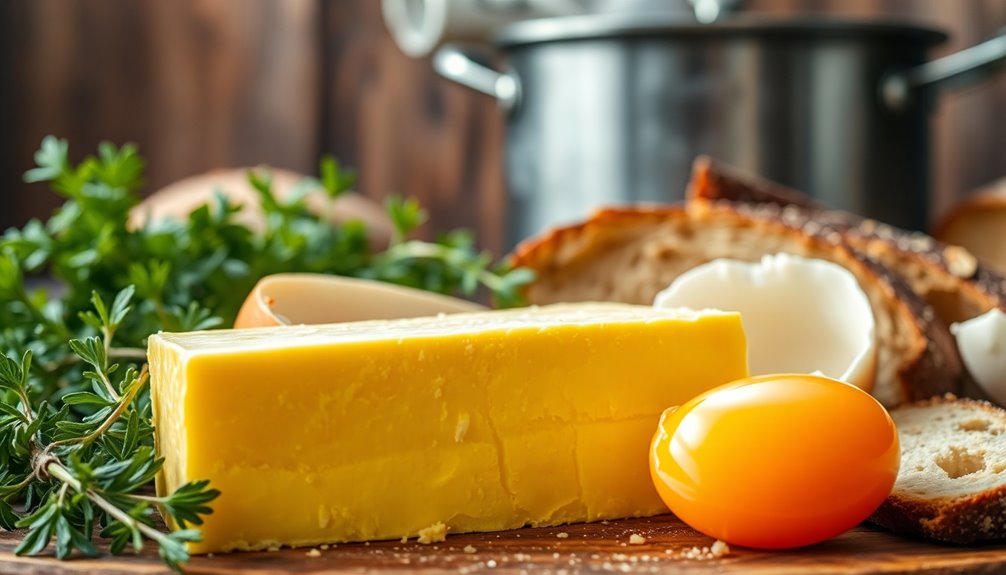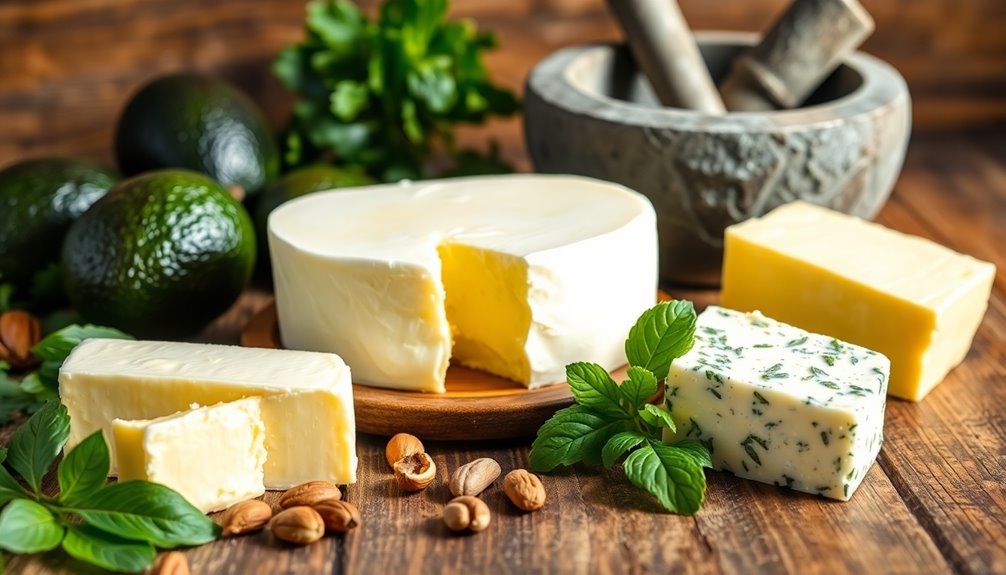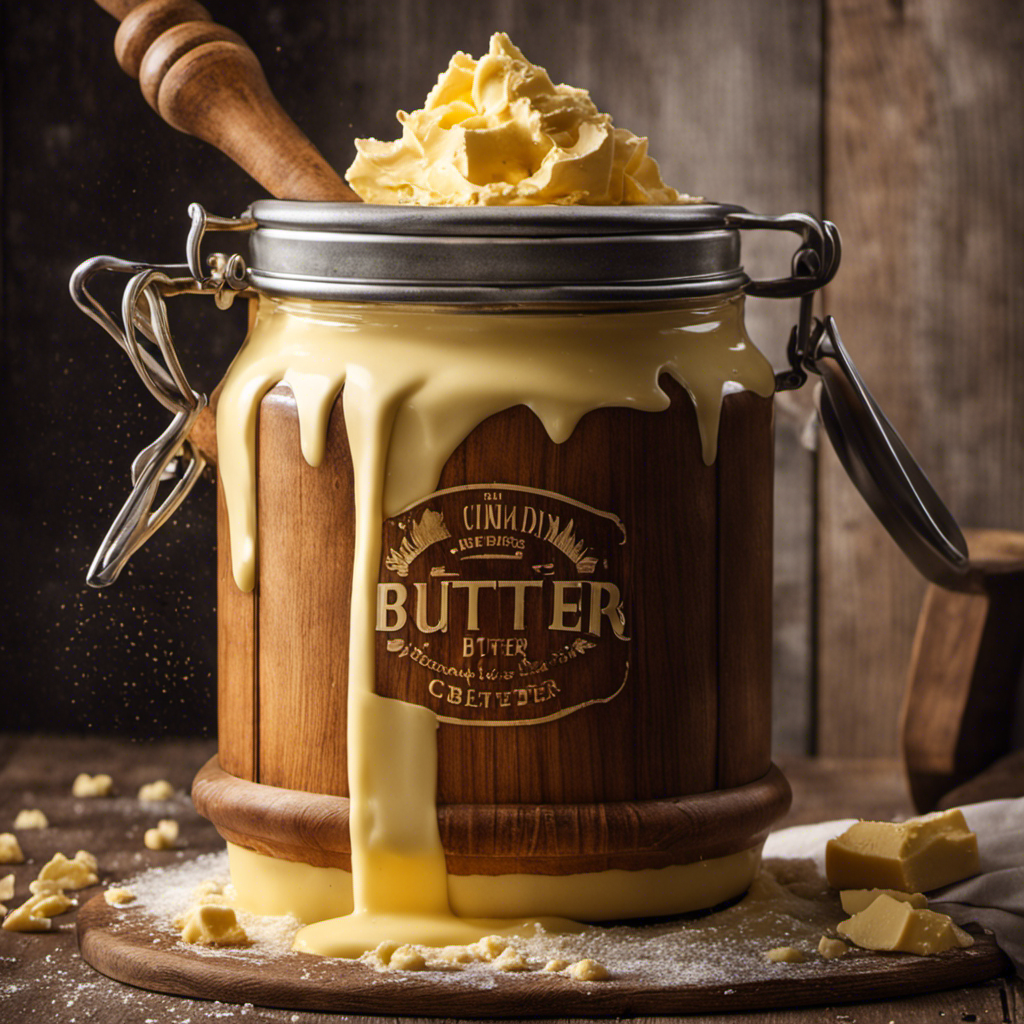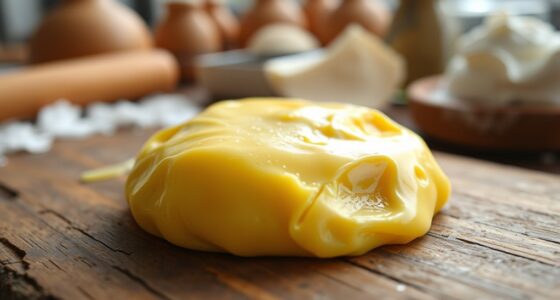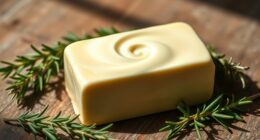Sweet-cream butter is made from fresh, pasteurized cream, offering a mild, creamy flavor and a smooth texture, while cultured butter is fermented, giving it a tangy taste and a slightly firmer feel. Nutritionally, cultured butter contains probiotics that can support digestion, unlike sweet-cream butter. Both are rich in vitamins, but their flavor profiles and health benefits differ. To discover more about their unique qualities, explore further to make the best choice for your culinary needs.
Key Takeaways
- Sweet-cream butter is made from fresh, pasteurized cream with a mild flavor, while cultured butter undergoes fermentation, resulting in a tangier taste.
- Cultured butter contains probiotics from fermentation, offering digestive health benefits; sweet-cream butter does not have probiotics.
- Both types are high in fat-soluble vitamins (A, D, E, K), but cultured butter may have slightly higher nutritional value due to fermentation.
- Sweet-cream butter typically has a softer, more spreadable texture; cultured butter is firmer with a slightly grainy appearance.
- Nutritionally, sweet-cream butter provides quick energy, whereas cultured butter supports gut health through beneficial bacteria.
Production Processes and Origins
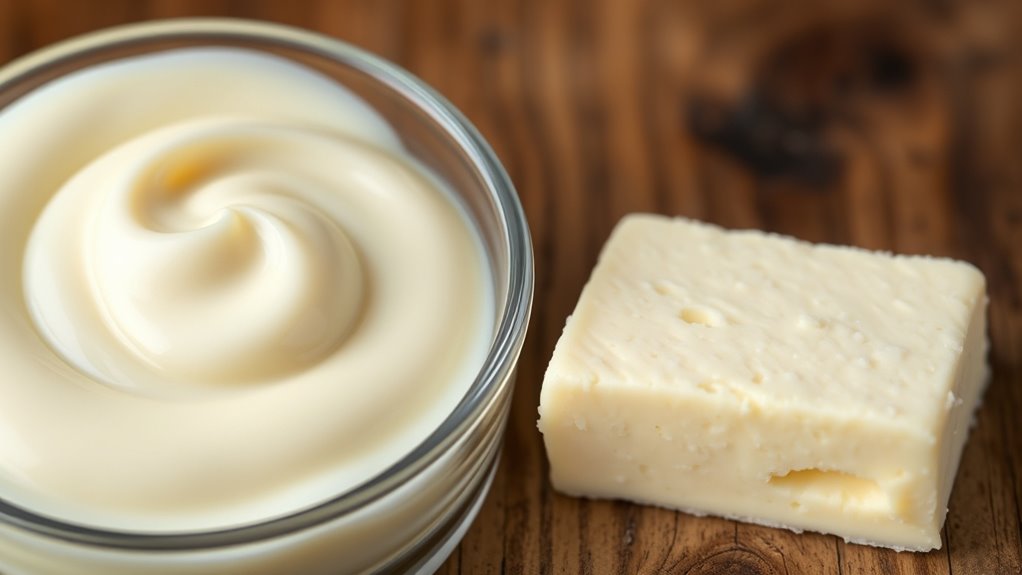
Sweet-cream butter is made from fresh, high-quality cream that is pasteurized and churned until the fat separates from the liquid. Its dairy origins trace back to cow’s milk, specifically from the cream extracted during milk processing. Unlike cultured butter, which involves fermentation methods, sweet-cream butter skips this step, resulting in a milder flavor. The dairy origins of sweet-cream butter highlight its reliance on high-quality milk and careful handling to preserve freshness. The production process emphasizes minimal intervention, focusing on mechanical churning rather than fermentation. This simplicity produces a creamy, delicate butter with a clean taste. In contrast, cultured butter’s dairy origins include added bacterial cultures, which ferment the cream, creating a richer, tangier profile. Additionally, the production techniques used for sweet-cream butter contribute to its straightforward flavor profile and smooth texture.
Flavor Profiles and Culinary Uses

You’ll notice that sweet-cream butter has a mild, creamy flavor, while cultured butter offers a tangy, more pronounced taste. These differences influence how you use them in cooking and pairing with other ingredients. Understanding their flavor intensities helps you choose the best butter for specific recipes and dishes. Additionally, vitamin content can vary between these butters, impacting their nutritional profiles and health benefits.
Flavor Intensity Differences
While both sweet-cream and cultured butter offer rich dairy flavors, they differ markedly in their intensity and complexity. Sweet-cream butter has a mild, subtle butter flavor that enhances dishes without overpowering other ingredients. Its taste differences are often characterized by a clean, creamy sweetness, making it versatile in baking and spreading. Cultured butter, on the other hand, delivers a more pronounced and tangy flavor profile due to fermentation, which amplifies its butter flavor and adds depth. This heightened flavor intensity makes cultured butter especially noticeable in simple preparations where its complexity can shine. If you’re seeking a gentle, delicate taste, sweet-cream butter is ideal. For a richer, more pronounced flavor, cultured butter provides a bold taste difference that can elevate your culinary creations. Incorporating vintage dairy techniques can also influence the flavor profile of these butters, adding to their unique characteristics.
Cooking and Pairing Variations
Because of their distinct flavor profiles, sweet-cream and cultured butter lend themselves to different culinary applications and pairings. Sweet-cream butter’s mild, creamy taste makes it ideal for baking, spreading, and dishes where a subtle butter flavor is desired. It pairs well with fruits, honey, and light herbs. Cultured butter’s tangy, complex flavor stands out in savory dishes and adds depth to sauces and spreads. You might choose it over sweet-cream butter in recipes that benefit from its richer profile or as a flavor enhancer. If you’re looking for healthier options, consider butter substitutes that mimic either butter’s flavor or texture. Overall, understanding these differences allows you to select the best butter type or substitute, elevating your cooking and creating well-balanced flavor pairings. Flavor profiles play a crucial role in determining the best culinary uses for each type of butter.
Texture and Appearance Differences

You’ll notice that sweet-cream and cultured butter differ in their visual textures and shapes. Sweet-cream butter tends to have a smoother, more uniform appearance, while cultured butter often shows a slightly grainier look. These differences in consistency and form can influence how each butter interacts with your dishes. Additionally, the appearance of the butter can reflect their different production methods and fermentation processes.
Visual Texture Variations
Sweet-cream butter typically has a smooth, glossy surface with a soft, spreadable appearance, reflecting its high butterfat content and fresh processing. Its visual contrast is subtle, with a uniform, creamy hue that highlights its freshness. The surface sheen is often bright and reflective, giving it an inviting look. Cultured butter, on the other hand, may display a slightly more matte finish with a less pronounced surface sheen, due to fermentation processes that can introduce tiny bubbles or slight variations in color. These visual differences help you distinguish between the two at a glance. While sweet-cream butter appears more polished and consistent, cultured butter can show a more complex visual texture, hinting at its richer flavor profile. This contrast enhances your sensory experience before even tasting. Additionally, understanding visual texture variations can help consumers select the right butter for their culinary needs.
Consistency and Shape
While both sweet-cream and cultured butter are spreadable, their textures and shapes differ especially. Sweet-cream butter tends to have a higher creaminess level, making it softer and more uniform in shape. Cultured butter often feels firmer with a slightly grainier texture, giving it a distinct shape consistency. You might notice that sweet-cream butter spreads easily even when cold, maintaining a smooth appearance. Cultured butter may require a little more warmth to achieve similar spreadability and can sometimes hold a slightly irregular shape. Additionally, texture consistency can be influenced by factors such as fermentation and processing methods.
Nutritional Content and Benefits
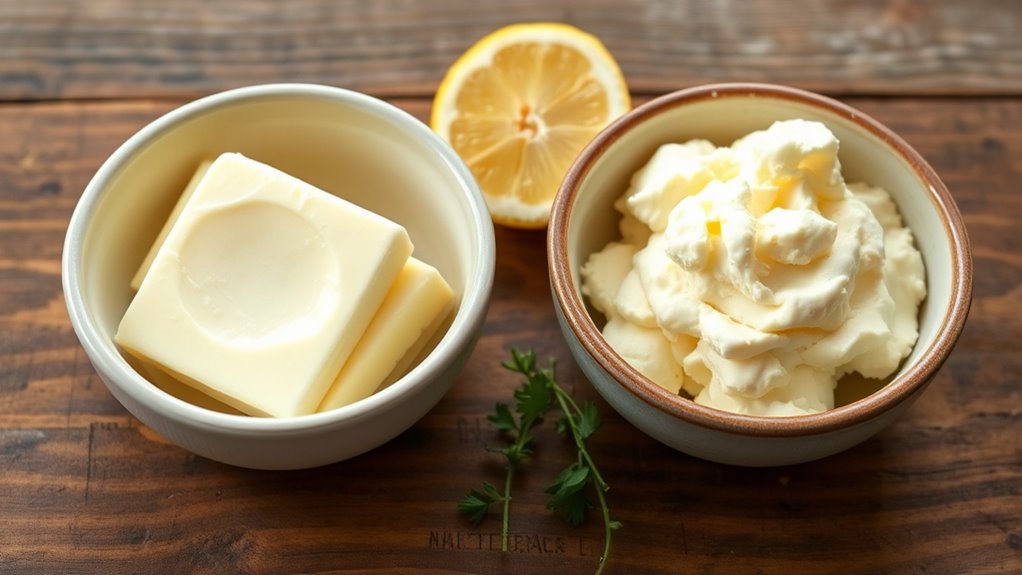
Both sweet-cream and cultured butter offer distinct nutritional profiles that can benefit your diet in different ways. Sweet-cream butter tends to have a slightly higher fat content, providing quick energy and supporting hormone production, which offers notable nutritional advantages. Cultured butter, meanwhile, contains probiotics from fermentation, which can enhance your immune system and promote better nutrient absorption. Both types are rich in fat-soluble vitamins like A, D, E, and K, contributing to eye health, bone strength, and immune function. Additionally, relationship patterns can influence how you incorporate these butters into your diet, depending on your dietary goals and preferences. While butter should be consumed in moderation, it can be part of a balanced diet offering essential nutrients. Your choice between the two can influence your intake of these health benefits, depending on your dietary goals and preferences.
Impact on Digestive Health
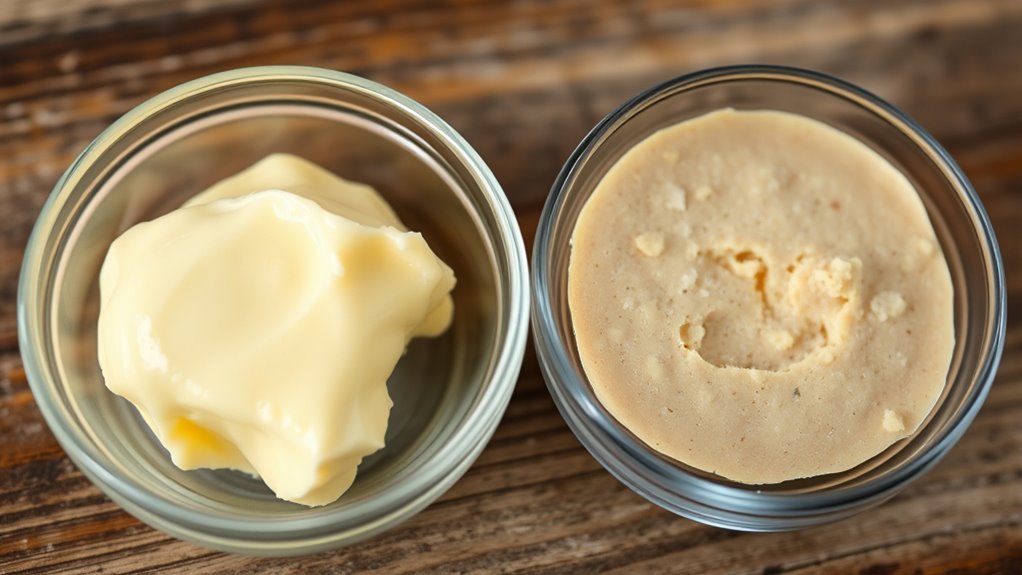
Cultured butter can positively impact your digestive health because of its probiotic content, which promotes a healthy gut microbiome. These beneficial bacteria enhance digestion by supporting digestive enzyme effects, helping your body break down food more efficiently. Consuming cultured butter may reduce bloating and improve nutrient absorption, making your gut happier. Its probiotics can also inhibit harmful bacteria, maintaining balance in your digestive system. Unlike sweet-cream butter, which lacks probiotics, cultured butter offers these gut-friendly benefits. Incorporating it into your diet aligns with the ancient wisdom of fostering inner harmony and balance, supporting overall digestive health and feeling more energized.
- Supports healthy gut bacteria
- Enhances digestive enzyme activity
- Reduces bloating and discomfort
- Improves nutrient absorption
- Maintains gut microbiome balance
Shelf Life and Storage Tips
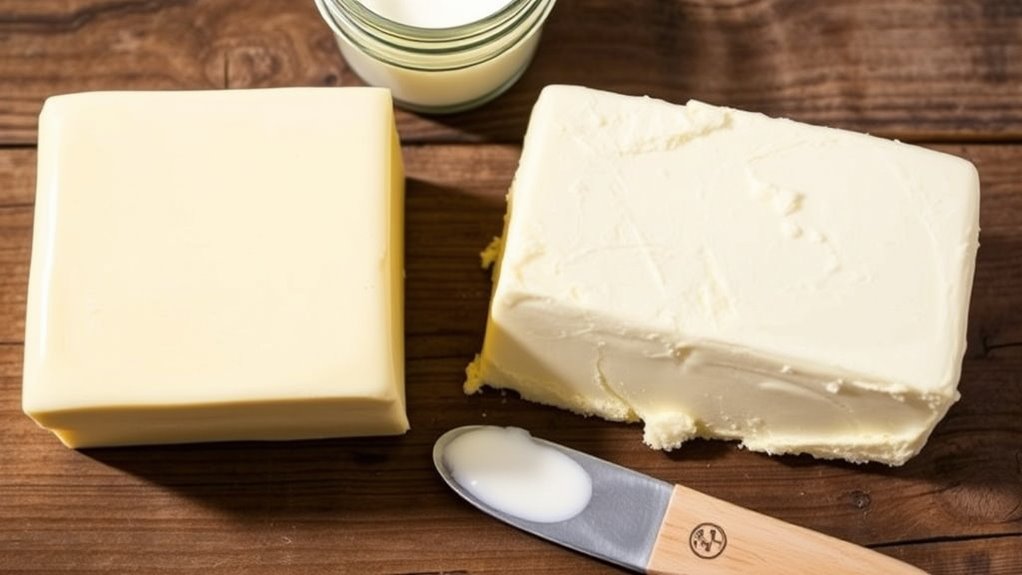
Proper storage is essential to keep your butter fresh and flavorful for as long as possible. To maximize storage duration and prevent spoilage, keep butter refrigerated at or below 40°F (4°C). Use airtight containers or wrap it tightly in aluminum foil or plastic wrap to prevent exposure to air and odors. For longer storage, consider freezing butter, which can preserve it for up to 6-9 months. When thawing, do so gradually in the fridge to maintain quality. Here’s a quick guide:
| Storage Method | Duration |
|---|---|
| Refrigerator | 1-3 weeks |
| Freezer | 6-9 months |
| Airtight Wrap | Prevents spoilage, maintains freshness |
| Avoid Room Temp | Leads to quicker spoilage |
| Check Regularly | Discard if rancid or moldy |
Additionally, proper storage can help preserve the nutritional quality of your butter over time. Following these tips helps prevent spoilage and keeps your butter tasting its best.
Selecting the Right Butter for Your Needs
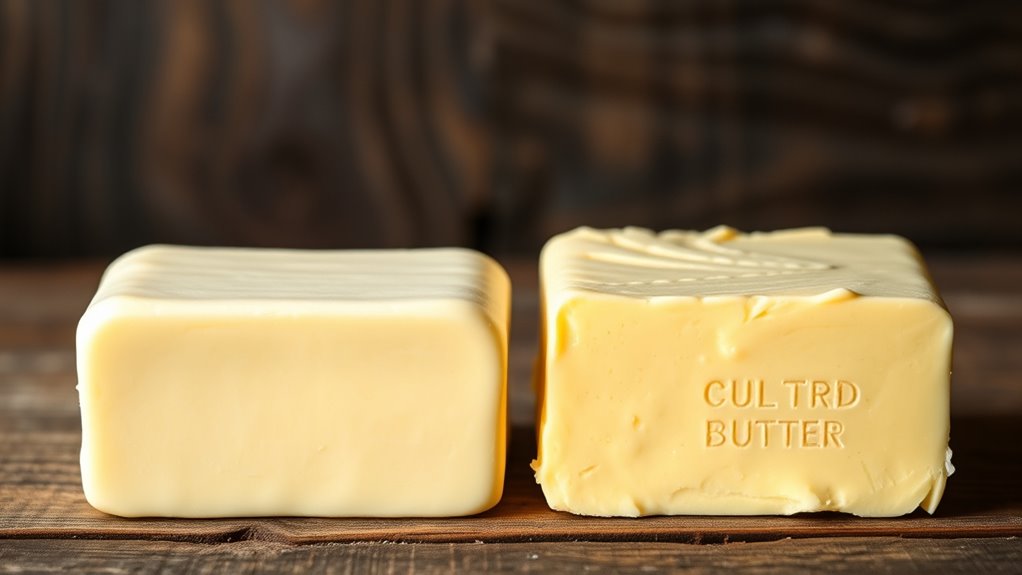
Choosing the right butter depends on how you plan to use it and the flavor profile you prefer. For baking, sweet-cream butter offers a mild, creamy taste that blends well in pastries. Cultured butter has a tangy, complex flavor that enhances savory dishes. Consider flavor pairing: cultured butter pairs beautifully with cheeses and hearty bread, while sweet-cream works well in desserts. Dietary considerations also matter—if you need a lower-sodium option, check labels carefully. If you’re lactose-sensitive, some cultured butters may be easier to digest. Think about texture; sweet-cream butter tends to be softer, ideal for spreading, while cultured butter can be firmer. Ultimately, choose based on your taste preferences and dietary needs.
Frequently Asked Questions
Which Butter Type Has a Longer Shelf Life?
You might wonder which butter lasts longer. Generally, cultured butter has better storage stability due to its fermentation process, which reduces spoilage rates. Sweet-cream butter, being less processed, tends to spoil faster if not stored properly. To maximize shelf life, keep your butter in an airtight container in the fridge. Cultured butter’s fermentation helps it resist spoilage longer, making it the better choice for extended storage.
Are There Any Allergen Differences Between Sweet-Cream and Cultured Butter?
If you’re concerned about dairy allergies or lactose content, you’ll want to know that sweet-cream and cultured butter generally have similar allergen profiles. Both contain milk proteins and lactose, which can trigger reactions in sensitive individuals. However, cultured butter often undergoes fermentation, which slightly reduces lactose levels. Still, if you have severe dairy allergies, it’s safest to avoid both types or choose clarified butter or ghee.
How Do the Production Costs Compare for Each Butter Type?
When comparing production costs, you’ll find that the process influences expenses. Cultured butter involves an additional fermentation step, which adds to labor and ingredient costs, making it more expensive. Sweet-cream butter skips fermentation, reducing production complexity and cost factors. If you’re considering production, remember that cultured butter’s extra steps and ingredients typically mean higher costs, while sweet-cream butter’s straightforward process keeps expenses lower.
Can the Flavor Profiles Influence Pairing With Specific Dishes?
You can definitely consider flavor profiles when pairing butter with dishes. Sweet-cream butter offers a mild, creamy taste that complements baked goods and delicate dishes, enhancing their natural flavors. Cultured butter, with its tangy, complex notes, pairs well with savory dishes like roasted vegetables or hearty bread, adding depth. Think about dish complementarity to choose the best butter, ensuring your flavor pairing elevates the overall culinary experience.
Are There Regional Preferences for Sweet-Cream Versus Cultured Butter?
Regional tastes and cultural influences shape your preference for sweet-cream versus cultured butter. In some areas, like France, cultured butter is favored for its rich, tangy flavor that complements local dishes. Meanwhile, in the US, sweet-cream butter is more common due to traditional dairy practices. Your choices often reflect local culinary traditions, highlighting how regional preferences are deeply rooted in cultural influences and historical dairy production methods.
Conclusion
Choosing between sweet cream and cultured butter is like picking the perfect paint color for your home—you’ll want what best suits your taste and needs. Sweet cream butter offers a mild, creamy flavor, ideal for baking, while cultured butter provides a tangy depth perfect for spreading or finishing dishes. Consider your flavor preference, nutritional goals, and culinary plans to make the best choice—after all, the right butter can elevate your cooking from good to extraordinary.
